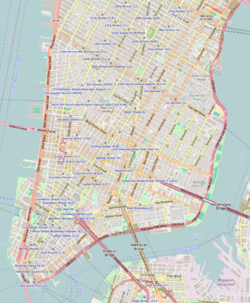Bouwerie Lane Theatre
Bouwerie Lane Theatre (Bond Street Savings Bank) | |
 | |
| Location | Manhattan, New York City, New York |
|---|---|
| Coordinates | 40°43′32″N 73°59′32″W / 40.72556°N 73.99222°W |
| Built | 1874 |
| Architect | Henry Engelbert |
| Architectural style | French Second Empire |
| NRHP reference No. | 80002671 |
| Significant dates | |
| Added to NRHP | April 23, 1980 |
| Designated NYCL | January 11, 1967 |
The Bouwerie Lane Theatre is a former bank building which became an Off-Broadway theatre, located at 330 Bowery at Bond Street in Manhattan, New York City. It is located in the NoHo Historic District. The cast-iron building, which was constructed from 1873-1874, was designed by Henry Engelbert in the Italianate style for the Atlantic Savings Bank, which became the Bond Street Saving Bank before the building was completed.[1] When the bank failed in 1879, the building was sold to the German Exchange Bank, which served the German immigrant community.[1] Prior to the 1960s, the building was used for the storage of fabrics.[2]
In 1963, the building was converted into a theater by Honey Waldman, who produced several plays there.[2] From 1974 to 2006, it was the home of the Jean Cocteau Repertory Theatre.[3] Among the many plays and musicals that were produced at the theatre, the first was The Immoralist (1963) with Frank Langella, Dames at Sea (1968), Night and Day (2000) by Tom Stoppard, Brecht's The Threepenny Opera (2003), and the Cocteau's final production, Jean Genet's The Maids X 2 (2006).[4][5] The building was purchased by Adam Gordon in 2007 for conversion into a private mansion with a climbing wall, and the Bowery frontage used for retail.[2]
In 1967, the building was designated a New York City landmark,[1] and it was added to the National Register of Historic Places in 1980.[6] The AIA Guide to New York City calls it "One of the most sophisticated cast-iron buildings."[7]
See also
[edit]- National Register of Historic Places listings in Manhattan below 14th Street
- List of New York City Designated Landmarks in Manhattan below 14th Street
References
[edit]Notes
- ^ a b c New York City Landmarks Preservation Commission; Dolkart, Andrew S.; Postal, Matthew A. (2009). Postal, Matthew A. (ed.). Guide to New York City Landmarks (4th ed.). New York: John Wiley & Sons. ISBN 978-0-470-28963-1., p.62
- ^ a b c Curbed article, "The Schrager Effect: Noho Readies the Cranes", September 27, 2007 Archived May 5, 2008, at the Wayback Machine
- ^ "From the Ashes of the Cocteau Repertory, a New Company Is Born", The New York Times (March 27, 2007)
- ^ Genzlinger, Neil (5 April 2006). "'Maids x 2,' Contrasting Two Styles of Jean Genet". The New York Times.
- ^ "Bouwerie Lane Theatre" Archived 2007-09-12 at the Wayback Machine at the Internet Off-Broadway Database
- ^ "Bouwerie Lane Theatre"[permanent dead link] on the National Register database
- ^ White, Norval & Willensky, Elliot (2000). AIA Guide to New York City (4th ed.). New York: Three Rivers Press. ISBN 978-0-8129-3107-5., p.168
External links
[edit]- Cast-iron architecture in New York City
- Theatres on the National Register of Historic Places in Manhattan
- Off-Broadway theaters
- New York City Designated Landmarks in Manhattan
- Henry Engelbert buildings
- Italianate architecture in New York City
- Commercial buildings completed in 1874
- Bank buildings in Manhattan
- Bowery
- 1963 establishments in New York City





